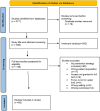Therapeutic Approaches for the Prevention of Upper Limb Repetitive Strain Injuries in Work-Related Computer Use: A Scoping Review
- PMID: 38844712
- PMCID: PMC12089234
- DOI: 10.1007/s10926-024-10204-z
Therapeutic Approaches for the Prevention of Upper Limb Repetitive Strain Injuries in Work-Related Computer Use: A Scoping Review
Abstract
Purpose: To explore and describe therapeutic approaches for the prevention of upper limb (UL) repetitive strain injuries (RSI) amongst computer users in the twenty-first century.
Methods: A scoping review was conducted using the method described by Arksey and O'Malley, further enhanced by Levac et al. to ensure rigor, validity and reliability during analysis. Key concepts pertaining to the research question have been mapped, following comprehensive searches of relevant electronic databases namely EBSCOHost (Academic Search Premier, CINAHL, eBook Collection, E-Journals, Health Source-Consumer Edition, Health Sources-Nursing/Academic Edition and MEDLINE), PUBMED and Google Scholar. The identified studies have been presented in a descriptive numerical summary to address the research aim.
Results: From the 577 studies initially identified, 58 studies were eligible for inclusion in the scoping review after abstract and full text screening. Strategies for the prevention of UL RSIs in computer users were categorised into overarching types of intervention as well as the factors which contribute towards sustained implementation of prevention strategies. Using ergonomic equipment was the most prevalent approach during intervention, breaks and rest periods were found to be the less common intervention offered to prevent RSIs. The majority of the studies noted personal worksite adjustments, including adjustments of the chair, back rest, lumbar support, handles or any arm support to the individual as a strategy to prevent UL RSIs. In high income countries the use of ergonomic equipment was the most common type of approach during intervention, in middle income countries stretches were the most common therapeutic intervention strategy and in low-income countries there was an even distribution between a number of different therapeutic interventions aimed at preventing RSIs.
Conclusions: The review provides an overview of approaches and a comprehensive baseline for identifying further research required to generate prevention approaches. The information within the review may be used to impact company practice, policy and decision making in terms of developing prevention strategies.
Keywords: Cumulative trauma disorders; Primary prevention; Therapeutic uses; Upper extremity; User-computer interface.
© 2024. The Author(s).
Conflict of interest statement
Declarations. Conflict of interest: The authors declared no potential conflicts of interest with respect to the research, authorship, and/or publication of this article. Ethical Approval: No ethical approval was required. Guarantor: AdW. Informed Consent: No consent for participation of publication was required.
Figures
References
-
- Miller R, Michalski W, Stevens B. The promises and perils of 21st century technology: an overview of the issue. In: 21st Century technologies. Organisation for Economic Co-operation and Development; 1998. p. 7–33.
-
- Marcoux BC, Krause V, Nieuwenhuijsen ER. Effectiveness of an educational intervention to increase knowledge and reduce use of risky behaviors associated with cumulative trauma in office workers. Work. 2000;14(2):127–135. - PubMed
-
- Goodman G, Kovach L, Fisher A, Elsesser E, Bobinski D, Hansen J. Effective interventions for cumulative trauma disorders of the upper extremity in computer users: practice models based on systematic review. Work. 2012;42(1):153–172. - PubMed
-
- Taylor K. The research on Repetitive Strain Injuries and breaks. Wellnomics White Paper. 2006. p. 1–9.
-
- Yu Z, James C, Edwards S, Snodgrass SJ. Differences in posture kinematics between using a tablet, a laptop, and a desktop computer in sitting and in standing. Work. 2018;61(2):257–266. - PubMed
Publication types
MeSH terms
LinkOut - more resources
Full Text Sources
Medical




